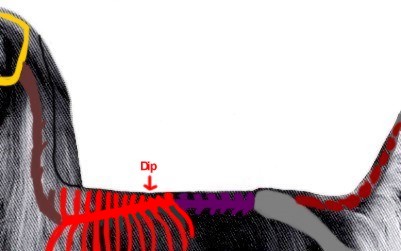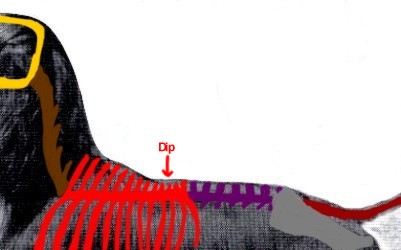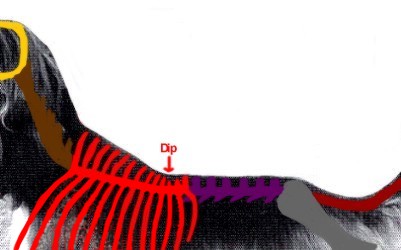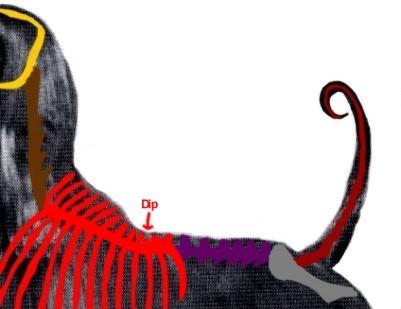The backline of the
Afghan Hound
collected and illustrated by Diana Lüdemann.
The Afghan Hound shows a broad variablity of backlines appearing
rather different to the eye.
They range from really straight backs over pronounced wither to
a divided back into two pieces
with the most extreme case of withers appearing more part of the
neck than the back:
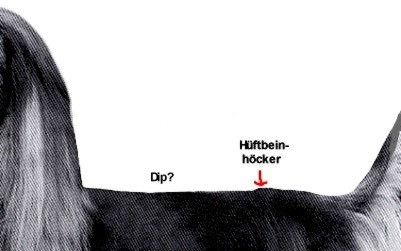 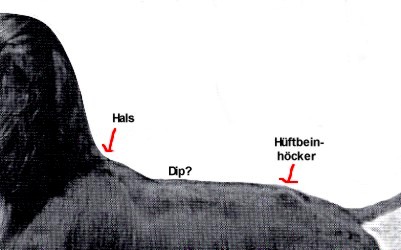 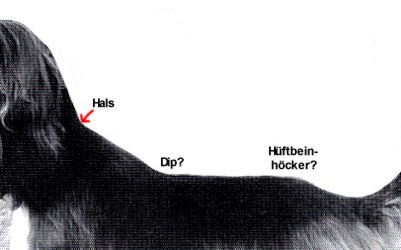 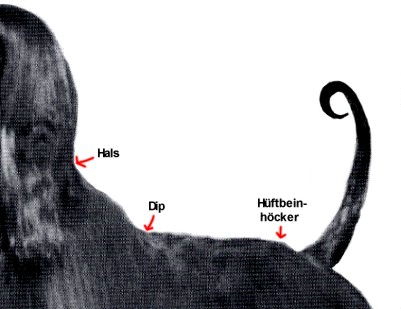 |
|
straight back |
pronounced withers |
divided back (two parts) |
|
In view of those backlines which one is demanded the corrected
du to the breed standard?
Theory and practise: Which backline is the most common in reality
and why?
Before studying the standard and analysing photo examples
let's have a look at the bones underneath.
At the outset: The key seems to be the degree of flexibility of the
thoracic vertebrae,
exspecially at the 11. one, which is visible in most pictures as
the "dip":
A detailled anatomically explanation
of the above illustrations
see on the next page: spinal
column:
After generatining the picture of the connection of
the optical backline and
its bones creating those appearences by means of the
page "The
spinal column"
we can ask the standard what he prefers to see in
Afghan Hounds:
The breed standards regarding backlines:
All four Afghan Hound illustrations (see under "The
spinal column") agree in one point:
the back has to be straight from the shoulders to the hip bones.
The FCI-Standard demands for a level back,
a straight loin and a slightly falling croup.
The America standard demands for a "back line appearing practically
level from the shoulders to the loin",
a slightly arched loin and a falling croup.
| FCI-Standard and Australian
standard |
AKC-Standard (U.S.) |
Back level, moderate
length, well muscled,
back falling
slightly away to stern.
Loin straight,
broad and rather short.
Hip bones rather
prominent and wide apart. |
The back line
appearing practically level from the shoulders to the loin. Strong
and powerful loin and slightly arched, falling away toward the stern, with
the hipbones very pronounced. |
|
How to interpret this clear demands for a "level back"?
In colloquial speech the "back" unites the thoracic vertebrae and the
lumbar vertebrae,
therefore the "back" reaches from the set on of neck till the hipbones.
Does the American standard mean this: the points of the shoulder blades
lie close the 2. thoracic vertebrae.
Straight back from this point to the hip bones?? No, because the "practically"
level reduces this demand.
This interpretation doesn't play a role in the reality of the breed
Afghan Hound.
Anatomically the "back" is the thoracic spine, the thoracic vertebrae
1 to 13,
therefore the back is the whole distance of the withers (1. to 8. thoracic
vertebra) till a little behind the dip.
I think no standard means that the line of the withers should be a
straight line and horizontal to the ground.
The old formers who have set up the breed standards didn't refer to
this terminology.
In the past the kynologists have divided the "back line" into two
parts: the withers and the rest of the back.
The withers are raised because of the long thorns of the first seven
or eight thoracic vertebrae.
After them the remaining vertebrae have shorter thorns and are often
called the "back".
Therefore the "back" starts with the eighth or ninth thoracic vertebrae
and ends at the hip bones.
In this interpretation the Dip (eleventh thoracic vertebra) is a point
within a level back line.
This is meant by the formers of the FCI-Standard and is valid for the
Australians as well.
The FCI standards demands for a straight back from the end of the high
withers to the croup: that
means no or very little visible dip and no disturbation of the straight
line due to pronounced vertebrae.
The demanded well musculation across the whole back should not allow
too much of visisble spine as well.
The demand for a broad loin supports the impression of much musculation
covering the whole spine.
The FCI standard doesn't say anything about the withers, so it's not
forbidden to have them high naturally.
In my opinion the FCI standard most desires back line no.1. (see below)
I know that some Americans want to interpret their standard in this
way, too.
But does the wording "level from shoulders to the loin" allow this?
Historically this special American wording has taken the place of the
above British discription.
Why have the formers of the AKC standard changed the wording in this
way?
Wasn't they satisfied by the back line demanded by all the older British
standards?
Did they feel that another discription describes their dogs having
in mind more exactly?
I don't know, but I think the wording does allows a little different
interpretation:
"practically level" is almost level and perhaps allows a slightly falling
down of the withers to a visible dip
and a slightly up across the vertebrae behind the dip. Additionally
it's supported a slight arch of the loin
up and down towards the croup, which could lead astray to visible lumbar
vertebrae to show the demanded arch on first sight.
But is such a backline the same as the most desired by the FCI standard,
back line no.1? The pictures tell something else...
Aditionally this standards says nothing about the musculation of the
back, only loins have to be strong and powerful,
which can be achieved by the musculation on the sides. The vertebrae
itselves haven't to be covered by musculation.
The less musculation (in comparision to the FCI standard) shows up
in two points: no muscular back and no broad loin.
Last but not least the "very" pronounced hip bones exclude too much
musculation, which would cover this stressed feature.
Surprise: Does this show how much influence does every word in the
standards play? Or is it the different foundation gene pool?
. |
Optical appearances of back lines
in photographs,
devided into condition of musculation & food
(no. 1-3) and the flexibility of tendons and ligaments (no. 4)
(I've not translated my opinion why there are
those different toplines,
but I will tell You my system how I've categorized
them:
Back line no. 1 has "short withers" and long back
without visible dip.
Back line no. 2 shows "long withers" till the
dip, which is clearly determinable due to the following visible vertebrae.
Back line no. 3 allows to count each vertebrae
due to distinct visibility.
Back line no. 4 unites all previous back lines
and adds the new aspect of flexibility at the dip,
with allows different degrees of the slope of the wither segment.
The reasons are not transalted into Englisch,
only in German (on the German page).
Maybe added in future.
Large collection of photo examples:
Please choose for further examples the desired picture
out of the following table:
| Back
line no. 1: (FCI) |
Back
line no. 2: (AKC) |
Back
line no. 3: (visible vertebrae) |
 |
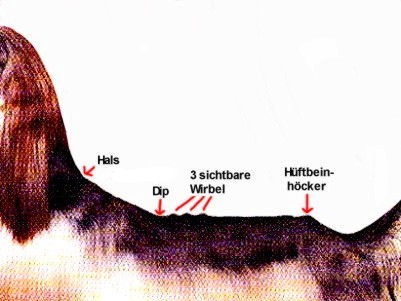 |

|
"short withers" and long level back
without visible dip or arch of loin |
"long withers" till the dip, which is clearly
determinable due to the visible vertebrae |
allows to count each vertebrae
due to distinct visibility |
| Back
line no. 4: (Flexibility) |
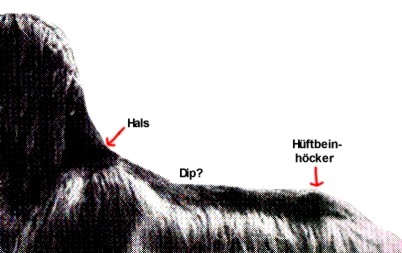   |
| unites all previous back lines and
adds the new aspect of flexibility at the dip for different degrees of
the slope of the wither segment |
If You would like to have further back lines presented on this website,
please contact me and send the picture!
As well let me know Your comments.

|




